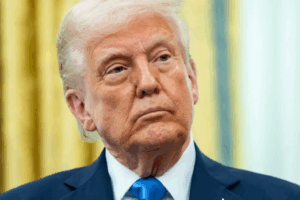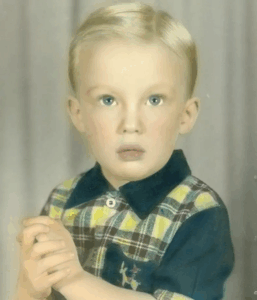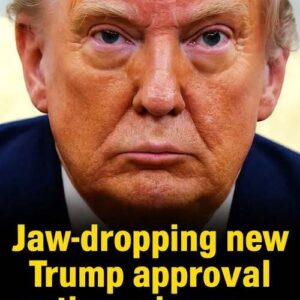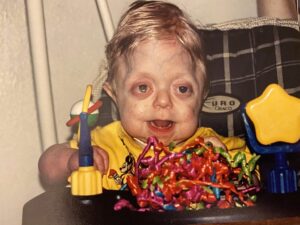At first glance, the image seems unremarkable—an ordinary portrait of a young, blond-haired boy, likely no older than four or five, sitting with an expression of quiet curiosity. His wide eyes gaze off-camera, his small mouth closed in a moment of childhood stillness. It’s the kind of photograph that could easily be found tucked inside a family album or framed on a grandmother’s mantle.
But what sets this photo apart is not the composition or lighting—it’s the identity of the child captured in that frozen moment.
Although very few people would recognize him immediately, that boy would grow up to become one of the most polarizing figures in the modern world. Today, he is known globally, a name that evokes either fierce loyalty or equally intense disdain. That boy is Donald John Trump, the 45th President of the United States.
When the photograph resurfaced in an Instagram post that quickly went viral, it ignited a storm of reactions. The comments section reflected a deeply divided public. Some users expressed warmth, writing things like, “What a sweet photo,” or “Hard to believe this little boy would one day lead the country.” Others, however, were openly critical—one wrote, “Not a monster. I support you,” while another commented, “It’s a tragedy that this child grew into one of the most morally bankrupt figures of our time.” Yet another said, “This boy became the most dangerous man in America.”
Why does a simple childhood image provoke such strong emotions? To understand, one must look beyond the photo and delve into the life that followed.
A Complicated Childhood
Donald Trump was born on June 14, 1946, in Queens, New York, the fourth of five children in the family of Fred and Mary Anne Trump. His father, Fred Trump, was a successful and strict real estate developer, known for his discipline and no-nonsense approach to business and parenting. Fred instilled in his children the belief that life was a competition—divided starkly between winners and losers. Vulnerability, in his view, was a weakness to be stamped out, not nurtured.
This black-and-white worldview shaped Donald early. Described by family members and teachers as energetic and assertive, young Donald was also prone to defiance and unruly behavior. His parents, concerned by his conduct at school and home, decided to send him to the New York Military Academy at age 13. There, structure was enforced not only through rules but also through physical discipline. Classmates and former cadets later recalled how quickly Trump adapted to the academy’s harsh environment.
“He ruled the dorms with an iron fist,” one biographer wrote, referencing interviews with fellow cadets. Trump, they said, could be domineering and competitive, often shouting commands at peers. For him, this wasn’t a traumatic experience—it was empowering. He thrived in a system that rewarded toughness and punished weakness.
His mother, Mary Anne, a Scottish immigrant, played a less forceful role in his development. During his formative years, she suffered from serious health complications following childbirth, which left her physically and emotionally unavailable for periods of time. That absence may have reinforced Donald’s alignment with his father’s values of dominance and detachment. Some psychologists have speculated that this lack of maternal softness further contributed to his bold, uncompromising personality.

The Rise of a Force
After graduating from the military academy, Trump eventually enrolled at Fordham University, and later transferred to the Wharton School at the University of Pennsylvania, where he earned a degree in economics. By his mid-20s, he had joined his father’s real estate business, and soon began reshaping it under his own vision.
Over the decades, Trump would evolve into a media-savvy mogul, developing a reputation for luxury, excess, and an unfiltered public persona. His name became a global brand, emblazoned on hotels, casinos, golf courses, and even steaks and ties. He cultivated fame as the star of the reality TV show The Apprentice, where his catchphrase “You’re fired” became iconic.
But it wasn’t until 2015, when he announced his candidacy for President, that Donald Trump would truly divide the country in an unprecedented way.

A President Like No Other
Trump’s 2016 election shocked the world. With no prior political or military experience, he defeated a seasoned politician, Hillary Clinton, and took office in January 2017. His presidency was marked by constant controversy, frequent use of social media to communicate directly with the public, and a radically different tone than any president before him.
Supporters hailed him as a patriotic disruptor, someone who put “America First,” challenged global institutions, and gave a voice to those who felt forgotten. Critics viewed him as authoritarian, divisive, and driven by ego, pointing to his rhetoric on immigration, handling of the COVID-19 pandemic, and repeated challenges to democratic norms as dangerous and destructive.
In 2020, Trump lost his reelection bid to Joe Biden, but refused to concede the results for weeks. His unfounded claims of election fraud culminated in the January 6, 2021 Capitol riot, when a mob of his supporters stormed the U.S. Capitol. The event led to his second impeachment, making him the only U.S. president in history to be impeached twice.
Even after leaving office, Trump has remained a central figure in American political life. He has continued to influence the Republican Party and has announced multiple bids for reelection. Loved by millions and loathed by millions more, he remains one of the most talked-about individuals in the world.
The Boy in the Picture
Now, when people look at that childhood photo of Donald Trump, they see far more than just a child. For some, it is a painful reminder that even the most ordinary beginnings can lead to extraordinary—and controversial—outcomes. For others, it’s a testament to ambition, strength, and perseverance in the face of intense opposition.
Regardless of where one stands politically, the journey from a little boy in Queens to the Oval Office is undeniably profound. That child, sitting quietly with wide eyes, would go on to become a billionaire businessman, a reality television star, a president, and a cultural lightning rod whose legacy is still being written.
That photo is no longer just a snapshot of innocence. It’s a symbol—a starting point of a life that would leave a permanent mark on American history.




